Adrian Jones (sculptor)
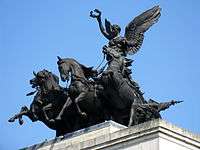
Adrian Jones MVO (9 February 1845 – 24 January 1938) was an English sculptor and painter who specialized in animals, particularly horses. He created the sculpture Peace descending on the Quadriga of War, on top of the Wellington Arch at Hyde Park Corner in London. Before becoming a full-time artist he was an army veterinary surgeon.
Life
Adrian Jones was born in Ludlow, Shropshire, and studied at the Royal Veterinary College, qualifying as a veterinary surgeon in 1866 . He enrolled in the Army as a veterinary officer in the Royal Horse Artillery the following year and served from 1867 to 1890. During this time he saw service in the Abyssinian Expedition of 1868 before joining the 3rd Hussars in 1869. From 1871 to 1881 he served with the Queen’s Bays in Ireland and was then attached to the 7th Hussars and fought with them in the Anglo-Transvaal war in 1881. In South Africa he was attached to the Inniskilling Dragoons. In 1884 Jones served in Egypt where he selected camels for the Nile Expedition and finally joined the 2nd Life Guards, retiring in 1890 with the rank of captain.
He was already active as an artist by this time, having exhibited at the Royal Academy as early as 1884, giving his address as "The Studio, Chelsea".[1]
On retirement from the Army he set himself up as an artist. His training as a veterinary surgeon gave him a deep knowledge of equine anatomy which he used in his work to great effect.
"Peace descending on the Quadriga of War"

Jones' best-known work is probably the sculpture "Peace descending on the Quadriga of War", which surmounts the Wellington Arch at Hyde Park Corner, London. This replaced an equestrian statue of the Duke of Wellington which is now at Aldershot. It was created as a memorial for Edward VII, and was placed on public view in 1912. File WORK 20/52 held at the National Archives gives some further background information on the "Quadriga". The period covered by the correspondence in this file opens in August 1890. We learn from these papers that in December 1907 Jones had the model ready for inspection and this was finally accepted in May 1908. There are several letters in the file from both Adrian Jones and A.B. Burton who cast the statue at his Thames Ditton Foundry.[2]
The casting was completed by November 1911 and the complex matter of hoisting the "Quadriga" into position took place in January 1912. In April 1912 the King and Queen drove through the arch and were presented to both Jones and Burton. In October 1913 the "Quadriga" was formally placed in the charge of Office of Works. At the back of the file are some press cuttings, and other miscellaneous papers. Another file held at the National Archives, WORK 20/122 covers the period November 1913 to March 1939 and in the main covers the addition of a tablet noting that the "Quadriga" was a gift of Lord Michelham. This was affixed in 1916. It is recorded that the young boy in Jones' composition for the "Quadriga" who is leading the four horses as they are descended upon by the Angel of Peace was in fact based on Lord Michelham's son. Letters dated February and March 1939 cover the siting of an Air Raid siren on the roof of the Wellington Arch.[3]
The Statue of Prince George, Duke of Cambridge

This statue stands in Whitehall and is another of Jones' magnificent representations of a horse. File WORK 20/58 held in the National Archives gives some background information on this statue covering the period January 1906 to July 1907. The statue was cast by A.B. Burton at his Thames Ditton Foundry[2] and was unveiled on 15 June 1907.[4]
Bronze Statue of Redvers Henry Buller

This statue is located in Exeter, Devon and dates to 1905. The image above is shown courtesy of its author Peter Clarkson[5]
Other works
| Name | Location | Comments | Image | |
|---|---|---|---|---|
| Memorial to the 6th Dragoon Guards (The Carabiniers) | Chelsea Greater London | This memorial is located on the Chelsea Embankment on the south-east corner of some gardens opposite Chelsea Bridge. The memorial features an Adrian Jones bronze relief and remembers the 76 men who served in the 6th Dragoon Giards and lost their lives in the Second Boer War of 1899 to 1902. There are four inscriptions. ” SOUTH AFRICAN WAR/ THE CARABINIERS/ 1899 - 1902” inscription over relief is located above the relief, ” IN MEMORY OF/ THE OFFICERS, N. C. OFFICERS AND MEN/ OF THE VI. DRAGOON GUARDS, (THE CARABINIERS)/ WHO GAVE THEIR LIVES FOR THEIR COUNTRY IN THE/ SOUTH AFRICAN WAR. 1899 - 1902./ ERECTED BY PAST AND PRESENT CARABINIERES./ AD 1905” inscription below relief is located below the relief. On one side of the memorial there is a plaque inscribed ” RELIEF OF KIMBERLEY/ PAARDEBURG. DRIEFONTEIN. JOHANNESBURG./ DIAMOND HILL. BELFAST &C/ OFFICERS, N. C. OFFICERS AND MEN/ KILLED IN ACTION/ (NAMES)” inscription on side of memorial and on the other side there is a plaque inscribed ” DIED OF WOUNDS OR DISEASE./ (NAMES)” inscription on the other side of memorial The memorial comprises a three-sided red brick and bath stone screen and Jones’ relief shows a mounted trooper holding the reins of three horses whilst his three comrades search a nearby kopse. The unveiling ceremony took place on 23 June 1906 and was performed by Field Marshal The Right Honourable Earl Roberts. See image right and another in the gallery below shown courtesy Lonpicman. File WORK 20/57 held at The National Archives in Kew contains some background information on this memorial and covers the period January 1905 to July 1906. The file includes a hand-written note from Adrian Jones, written from his 147, Church Street, Chelsea studio. |
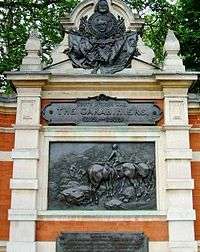 | |
| Royal Marine National Memorial | St James' Park Greater London | This memorial stands on The Mall just near to Admiralty Arch. The three inscriptions on the memorial read "ERECTED / BY THE OFFICERS AND MEN / OF THE / ROYAL MARINES / IN MEMORY OF THEIR / COMRADES WHO WERE KILLED IN ACTION / OR DIED OF WOUNDS OR DISEASE IN / SOUTH AFRICA AND CHINA / 1899 - 1900" inscription and "SOUTH AFRICA CHINA / (NAMES)" inscription and in a bronze ring on the ground around the memorial the third inscription reads "THIS MEMORIAL WAS REDEDICATED IN OCTOBER 2000 IN HONOUR OF ALL ROYAL MARINES WHO HAVE SERVED THEIR COUNTRY BY LAND AND SEA AND WHO ARE FOREVER REMEMBERED BY THEIR FRIENDS" inscription The memorial comprises Adrian Jones' bronze sculpture which stands upon a Portland stone pedestal. The sculpture depicts a marine lying wounded whilst a comrade with levelled rifle and bayonet stands to defend him. There are various bronze plaques on the memorial. One shows the Corps of Marines' badge, another depicts the action at Graspan and the repulse of a Chinese attack on the Peking Legation. Carved dolphins on each corner highlight the "naval nature" of the Marine Corps. Names are listed of marines who lost their lives in various conflicts. The memorial was unveiled on 25 April 1903 by HRH The Prince of Wales. Images on the right shown courtesy Sebastian Ballard. File WORK 20/55 held at The National Archives in Kew gives further background information on this particular memorial. Correspondence in this file starts in November 1901 and the final letter is dated 9 February 1911. Another National Archives file WORK 20/138 covers "care and maintenance" in the period August 1919 to June 1930. During the 1939-1945 war the memorial was stored at the yard of Holloway Bros in Nine Elms after removal from that part of St. James' Park adjoining the Admiralty (known as the "Cambridge" enclosure) and then moved to the grounds of the Royal Hospital, Chelsea. It was moved to its present site in 1948. File WORK 20/239 covers this period. Prior to removal to Holloway's yard it is recorded that the memorial had suffered slight damage from German bombing of the area in 1940. On 29 October 2001 and after some re-designing, HRH Prince Philip unveiled what was now known as The Royal Marine Memorial. HRH Prince Philip carried out the unveiling in his capacity of Captain General of the Royal Marines.[10] |
 | |
| Bridgnorth War Memorial | Bridgnorth Shropshire | This memorial stands in Bridgnorth's Castle Gardens. Apart from a list of names of those remembered, the memorial has two inscriptions"THEY WHOSE NAMES ARE RECORDED/ HEREON WERE NUMBERED AMONG THOSE/ WHO, AT THE CALL OF KING AND COUNTRY,/ LEFT ALL THAT WAS DEAR TO THEM,/ ENDURED HARDNESS, FACED DANGER &/ FINALLY PASSED OUT OF THE SIGHT OF/ MEN BY THE PATH OF DUTY AND SELF/-SACRIFICE, GIVING UP THEIR OWN LIVES/ THAT OTHERS MIGHT LIVE IN FREEDOM./ LET THOSE WHO COME/ AFTER SEE TO IT THAT/ THEY BE NOT FORGOTTEN" inscription and "ERECTED IN HONOUR/ OF THE/ MEN OF BRIDGNORTH/ WHO SERVED THEIR COUNTRY/ IN THE GREAT WAR 1914-1919/ AND TO THE/ EVER GLORIOUS MEMORY/ OF THOSE WHO FELL/ ALSO TO THE MEMORY/ OF THOSE WHO FELL IN/ THE SECOND WORLD WAR/ 1939-1945" inscription . A two stepped base is surmounted by a square plinth with pediment and the figure of a soldier of the King's Shropshire Light Infantry in battle dress with rifle slung over his shoulder. The soldier stands with his arm outstretched as if in the act of throwing a hand grenade. The names of 144 men lost in the First World War are listed and a further 48 names for those lost in the Second World War. Sadly the memorial has suffered several times from vandalism with the bayonet and rifle butt being a target for theft and damage. The original unveiling took place on 9 March 1920 with a further ceremony in November 1950 when the added names for the Second World War were unveiled. Photograph shown here courtesy Antony Hollingworth[11] |
 | |
| Uxbridge War Memorial | Uxbridge Middlesex | This memorial is dedicated to those men of Uxbridge who died in the First and Second World War. The memorial has the inscriptions"ERECTED/ IN HONOUR AND MEMORY/ OF ALL THOSE/ MEN AND WOMEN OF /UXBRIDGE/ WHO SERVED OR FELL/ IN THE GREAT WAR/ 1914-1918/ AN EXPRESSION OF GRATITUDE FROM/ THEIR FELLOW TOWNSMEN" inscription and "IN MEMORIAM/ 1939-1945" inscription and "SONS OF THIS PLACE LET THIS OF YOU BE SAID/ THAT YOU WHO LIVE ARE WORTHY OF YOUR DEAD/ THEY GAVE THEIR LIVES THAT YOU IN PEACE MAY REAP/ A RICHER HARVEST ERE YOU FALL ASLEEP" inscription The memorial comprises a stone column surmounted by Jones' bronze depicting a winged angel holding a laurel wreath. The unveiling took place on 11 November 1924. |
 | |
| Royal Gloucestershire Hussars Memorial | Gloucester Gloucestershire | This memorial stands on College Green outside the Cathedral and has reliefs by Jones. It comprises a large stone cross on a stepped stone plinth. The Regimental Badge in relief is below the shaft of the cross and Jones' reliefs depict soldiers feeding their horses and in another a soldier is showing others the way to go. There are four panels in all and they depict scenes from Gallipoli, Syria, Sinai and Palestine. The names of 225 men of the Regiment who gave their lives in the First World War are listed. The memorial was unveiled in 1922.[12] |  | |
| Cavalry of the Empire Memorial | Hyde Park Greater London | This memorial is dedicated to the Cavalry and is inscribed "ERECTED/ BY THE/ CAVALRY OF THE EMPIRE/ IN MEMORY OF/ COMRADES/ WHO GAVE THEIR LIVES/ IN THE WAR/ 1914-1919/ ALSO/ IN THE WAR/ 1939-1945" inscription Jones' composition features St George on horseback with a coiled dragon at his feet, this mounted on a pedestal behind which are stone screens with lists of all the Cavalry Regiments which saw service in World War One and the names of the four Field Marshals who had command of those Regiments. The unveiling took place on 21 May 1924, the ceremony being performed by Sir J D P French, The Earl of Ypres. Apart from the photograph shown on the right there are others in the gallery below. The National Archives in Kew hold several files which give us further information on this memorial. The first is WO 32/5896 and this contains a photograph taken from the "Times" of 22 May 1924 which shows Adrian Jones standing next to Lord Ypres as the statue is unveiled. The file includes details of the regiments who were represented at the unveiling ceremony and has a detailed description of the Memorial itself. Interesting to note that the bronze statue was cast from guns taken by the Cavalry in the Great War and that advice was taken from Major Victor Farquharson, an armour expert and Sir. H. Farnham Burke, Garter King-at–Arms on the detail of the work. We learn that much of the armour was copied from the famous bronze effigy of the Earl of Warwick, dated 1454 and that the design for the horse and its furniture was adopted from the picture of St. George painted by Albrecht Dürer. We also learn that four Cavalry Officers were promoted to the rank of Field-Marshal during the war, and this led to four "batons" being placed between the columns of the names of the Regiments which formed the Empire’s Cavalry which stand at the rear of the Memorial. Another file WORK 20/251 covers the arrangements to add an inscription to cover World War II (1939-1945). |
 | |
| South Australian Contingents | Greater London | This work was originally positioned by Ludlow Town Hall but was moved in 1988 to the ]National Army Museum. It comprises a plaster cast of a mounted cavalry man who is grasping his rifle and appears ready for action. It commemorated those cavalry men of South Australia who gave their lives in the Second Boer War of 1899 to 1902. It is reported that a George Henry Goodall of the First South Australian Contingent posed for the sculpture and informed the artist on equipment and uniform used by South Australian soldiers in the Boer. It is believed that the Adelaide sculpture mentioned next was made from the plaster cast of the Ludlow work.[14] | ||
| South African War Memorial | Adelaide Australia | Jones was the sculptor of the statue of a horse and rider mounting the crest of a hill which forms the core of the South African War Memorial, dedicated to South Australians who served in the Second Boer War between 1899 and 1902. This is located outside Government House in Adelaide, South Australia.[15] | ||
| Plaque to Charles Berkeley Pigott | Winchester Hampshire | This unusual and striking memorial to Lieutenant-Colonel Charles Berkeley Pigott, CB, DSO, late of 60th Rifles and 21st Lancers, is one of various memorials in the North Aisle of Winchester Cathedral.[16] |  | |
| Colonel Asfur Dowla | Whereabouts unknown | A silver statuette of the A.D.C. to the Nizam of Hyderabad, shown at the Royal Academy in 1903.[1][17] | ||
| For the Faith | Whereabouts unknown | An 1903 Equestrian statuette, shown at the Royal Academy in 1903.[18] |
Death and Memorial
Jones died of influenza and bronchitis at his Chelsea home in January 1938 aged 92 and was cremated at Golders Green Crematorium. A memorial plaque to Adrian Jones is to be found at St. Laurence’s Church in Ludlow next to that remembering another famous Ludlow-linked man, the poet A.E.Housman.[19]
Gallery of images
-
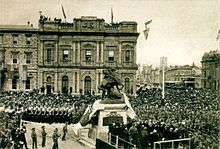
The unveiling of the Boer War Memorial in Adelaide.
-

Persimmon, Sandringham Stud, Norfolk. Image shown courtesy Mira66.
-

Adrian Jones' “Peace Quadriga” on Decimus Burton’s Wellington Arch. Shown courtesy Andreas Praefcke.
-

Another study the "Peace Quadriga”. Shown courtesy Eluveitie.
-
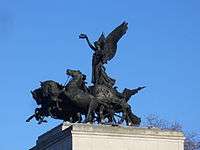
Another view "Peace Quadriga”. Shown courtesy Colin Smith
-

Relief on Cavalry Memorial
-

Head of Dragon-Cavalry Memorial
-

Plaque on Cavalry Memorial
-
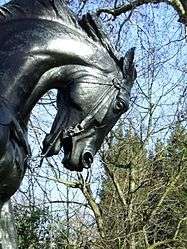
Head of Horse-Cavalry Memorial
-

Relief on Gloucester Memorial
-

Wounded Marine on Royal National Marine Memorial.
-
Carabiniers Boer War Memorial-Chelsea
Recommended reading
- "Triumph: The Life and Art of Captain Adrian Jones" by Robert S. Burns, published by Logaston Press www.logastonpress.co.uk ISBN 978 1 906663 44 5.
- "Memoirs of a Soldier Artist", published by Stanley Paul & Co. London 1933; Adrian Jones's autobiography.
- "Adrian Jones: Cavalry Officer, Veterinary Surgeon and distinguished Sculptor/Artist", article published by Veterinary History (pages 68–72)~ Journal of the Veterinary History Society, Vol 15 No.1, 2009. ISSN 0301-6943.
Obituary
Here is his obituary, published in The Times on 25 January 1938.
"CAPTAIN ADRIAN JONES HORSES IN SCULPTURE Captain Adrian Jones, the sculptor, died in London yesterday at the age of 92. He had been ill for several weeks with influenza and bronchitis.His professional career might be summed up by saying that he designed and executed the biggest piece of sculpture in London, the Peace Quadriga on Decimus Burton's Arch, Constitution Hill, and that he lived longer than any other sculptor of modern times. His own ideals in sculpture are expressed in an article, "A Testament of Beauty", which he contributed to The Times of April 10, 1935, on his ninetieth birthday, when he received the gold medal of the Royal Society of British Sculptors. Speaking of the principles he used in the execution of his work he said : The principles first of all say that nothing human or animal of God's creation should be in any way distorted or made a laughing stock of. Therefore the thing was to do an effigy in a simple pose which would carry with it the appearance of the object, or some other characteristics. I don't want people to think (he added) that I suggest a facsimile of any object that they are producing will represent the object they are seeking. All live things look bigger than dead ones. Secondly, a facsimile work of the model will never fill the eye or the sense of proportion. It has to be increased in different places without disturbing the anatomy to produce the effect of reality. It will be seen that between "distorting" and "increasing" there is room for many differences of opinion, and the plain truth is that between them lies the art, as distinct from the craft, of sculpture. In that art Jones was never very much at home, and his best works were in the nature of facsimiles of the model, slightly amplified. When, as in the Cavalry Memorial at Stanhope Geta, he allowed his imagination to suggest "some other characteristics", the result is not so happy. Jones will be remembered chiefly for two things : his profound knowledge of equine anatomy as affecting form in movement, and power of modelling the same, and his extraordinary command of the mechanical and technical side of his art. A point that is often forgotten is that even a bad piece of large-scale sculpture needs a great deal of knowledge and skill, not to speak of physical strength, to produce, and the Quadriga, though it is rather ragged in silhouette, is far from being a bad piece of sculpture. It owed its origin to a suggestion of King Edward VII as Prince of Wales, and those who had an opportunity to see the castings at Messrs. Burton's before they were assembled must always retain a respectful opinion of the capacities required for such a piece of work. Jones was born at Ludlow, Shropshire, on February 9, 1845, being the fourth son of James Brookholding Jones, and educated at Ludlow Gramar School. Taking up the veterinary profession, he served for 23 years in the Army- in the 3rd Hussars, Queen's Bays, and 2nd Life Guards- and saw active service in Abyssinia (medal), Boer War, 1881, and Nile Expedition (medal and clasp and Khedive's Star). On the advice of artistic friends he turned to painting and sculpture, studying under G. B. Birch, A.R.A. For a good many years he exhibited regularly at the Royal Academy, the Grosvernor Gallery, the Royal Institute, and the Paris Salon. Apart from the Quadriga and the Cavalry Memorial, he was responsible for the Royal Marines' Monument, St. James's Park and the Carabineers' Memorial; and among his other more important works were "Duncan's Horses"- his first success, exhibited in the Royal Academy of 1892, and one of the few things to escape the fire at the Crystal Palace ; the equestrian statue of the Duke of Cambridge, Whitehall ; "Persimmori" at Sandringham ; and General Sir Redvers Buller, V.C., at Exeter. His portrait of Lord Kitchener is at Ipswich, and he also painted an equestrian portrait of Sir David Campbell, Governor of Malta, on his Grand National winner, The Soarer and several works in pure landscape. He was made M.V.O. in 1907. In 1934 Jones was given the diploma of Honorary Associate of the Royal College of Veterinary Surgeons, and he was also an honorary member of the Incorporated Association of Architects and Surveyors. Of military and, in later life, rather rugged appearance, Jones was universally popular, not to say beloved, in art circles in Chelsea, where he lived. He was twice married : in 1870 to Miss E.E. Beckingham, and in 1891 to Miss Emma Wedlake, and had one son. In 1933 Jones published his reminiscences, which gave an interesting account of his military experiences - in the Abyssinian War in particular, where he was one of the first to enter the hut where King Theodore had shot himself with a revolver given to him by Queen Victoria- and of his methods of work, but devoted far too much space to refuting a stupid accusation that he was not the author of one of his works'. Similar accusations are not uncommon in the history of sculpture- Rodin, for example, was accused of exhibiting a cast from the living model-and nobody familiar with sculptural methods, and the necessary delegation of labour in the execution of large works, would think them worth more than a flat denial. The funeral service will be at Chelsea Old Church on Friday at 11.30. The cremation will be at Golders Green" Obituary
Work as a painter
| Wikimedia Commons has media related to Adrian Jones. |
Whilst so well known as a sculptor, Jones was an accomplished painter.[21]
References
- 1 2 Graves, Algernon (1905). The Royal Academy: A Complete Dictionary of Contributors from its Foundations in 1769 to 1904. 4. London: Henry Graves. p. 261.
- 1 2 Arthur Brian Burton (1860-1933) - British bronze sculpture founders and plaster figure makers, 1800-1980 - National Portrait Gallery website
- ↑ Full description of Wellington Arch English Heritage. Retrieved 16 November 2012
- ↑ The Statue of Prince George Victorian Web. Retrieved 16 November 2012
- ↑ Buller Statue Exeter Memories. Retrieved 16 November 2012
- ↑ "London’s Open Air Statuary" by Gleichen. Published 1928. Pages 91-92.
- ↑ "Adrian Jones" by Selwyn Hodson-Pressinger. Published in 1996. See pages 52-53.
- ↑ Memorial to the 6th Dragoon Guards (The Carabiniers) UKNIWM. Retrieved 15 November 2012.
- ↑ History of The Carabiniers National Army Museum. Retrieved 15 November 2012
- ↑ The Royal Marine National Memorial UKNIWM. Retrieved 15 November 2012
- ↑ Bridgnorth War Memorial UKNIWM. Retrieved 15 November 2012
- ↑ Royal Gloucestershire Hussars Memorial UKNIWM. Retrieved 15 November 2012
- ↑ "CAVALRY OF THE EMPIRE - WW1 Memorial" UKNIWM. Retrieved 15 November 2012
- ↑ South Australian Contingents UKNIWM. Retrieved 15 November 2012
- ↑ South African War Memorial Professional Historians Association (South Australia). Retrieved 16 November 2012
- ↑ Plaque to Charles Berkeley Pigott Victorian Web. Retrieved 16 November 2012
- ↑ Colonel Asfur Dowla Victorian Web. Retrieved 16 November 2012
- ↑ For the Faith Victorian Web. Retrieved 16 November 2012
- ↑ Memorial Plaque in Ludlow Ludlow Guide. Retrieved 17 November 2012
- ↑ Obituary and other information Retrieved 16 November 2012
- ↑ Paintings BBC Website. Retrieved 16 November 2012